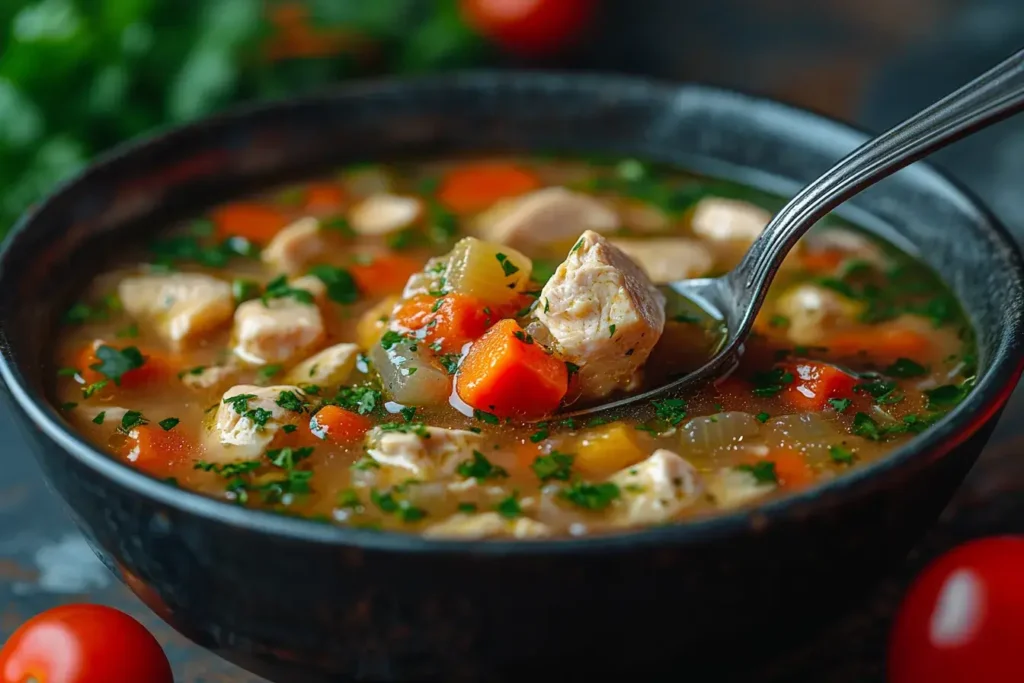
Chicken soup is the ultimate comfort food, a timeless dish that warms both the heart and soul. But have you ever wondered what is the secret ingredient in soup with chicken that takes it from ordinary to extraordinary? This article dives deep into the essentials of crafting flavorful chicken soup, uncovers the hidden gems that enhance its taste, and offers tips to elevate even the simplest recipes. Whether you’re a seasoned chef or just starting out in the kitchen, these insights will help you create soups that everyone will savor.
Table of Contents
The Basics of a Great Chicken Soup
Essential Components of Chicken Soup
At its core, chicken soup is a harmony of a few basic ingredients. Start with a robust broth—homemade or store-bought—and add tender chicken, fresh vegetables, and aromatic herbs. The combination of carrots, celery, and onions, often called the “holy trinity,” forms the foundation of flavor. Together, these ingredients create a balanced and satisfying soup.
Broth plays a starring role here. Homemade chicken stock, simmered for hours with bones and aromatics, provides unmatched depth and richness. However, high-quality store-bought broth can also do the trick if you’re short on time.
Why Chicken Soup Is Loved Across Cultures
Chicken soup has earned its place in kitchens worldwide. From Jewish matzo ball soup to Asian chicken noodle soup and Latin American caldo de pollo, every culture puts its unique spin on this dish. Its universal appeal lies in its simplicity, versatility, and ability to soothe, whether you’re feeling under the weather or just craving something warm.
This timeless dish isn’t just about sustenance—it’s also about tradition. Each spoonful tells a story, reminding us of family gatherings, cold winter nights, and cherished memories. But what makes one chicken soup stand out from another? That’s where the secret ingredient comes into play.
Stay tuned as we explore the building blocks of flavor and reveal the magic touch that transforms your chicken soup into a masterpiece.
Common Ingredients That Build Flavor

Aromatic Vegetables: The Holy Trinity of Soup
Every great chicken soup begins with a flavorful base, and that often starts with aromatic vegetables. Known as the “holy trinity” of soup-making, carrots, celery, and onions bring depth and balance to the broth. When sautéed together, these ingredients release their natural sweetness, creating a rich foundation that pairs perfectly with chicken.
Adding garlic to this mix takes the flavor up a notch. Its bold aroma and savory notes complement the mildness of chicken, making every bite more satisfying. Want even more complexity? Try incorporating leeks or shallots for a subtle twist.
Choosing the Right Chicken Cuts for Maximum Flavor
The type of chicken you use can make or break your soup. Bone-in, skin-on cuts like thighs, drumsticks, or whole chickens provide the best flavor. As they simmer, the bones release collagen, enriching the broth with a velvety texture.
If you’re short on time, pre-cooked or rotisserie chicken works well too. Just shred it and add it during the final minutes of cooking to prevent it from drying out. For a lighter option, use boneless, skinless chicken breasts, but be aware they won’t impart the same depth of flavor.
The Role of Herbs and Spices
Herbs and spices are the soul of chicken soup. Classics like thyme, bay leaves, and parsley infuse the broth with earthy, comforting notes. Add a pinch of black pepper and a touch of paprika for a subtle kick.
Experiment with fresh dill or cilantro for a brighter, fresher profile. When you’re pondering what is the secret ingredient in soup with chicken, remember that the right herb combination can transform a simple soup into a gourmet experience.
What Is the Secret Ingredient in Soup with Chicken?

Defining the ‘Secret Ingredient’: What Makes It Special?
The “secret ingredient” in chicken soup isn’t just about adding flavor it’s about creating a unique, memorable dish. It’s that one unexpected addition that sets your soup apart, leaving everyone asking for the recipe. While the classics like salt, pepper, and herbs are essential, secret ingredients go beyond the basics, amplifying depth and richness.
Top Contenders for the Best Secret Ingredients
Fish Sauce: An Umami Bomb
Just a few drops of fish sauce can elevate your chicken soup to a whole new level. This ingredient adds umami the savory taste that makes dishes more satisfying without overpowering the soup. It’s a secret used in many Asian kitchens and works wonders in brothy soups.
Miso Paste: A Savory Twist
Miso paste isn’t just for miso soup. Adding a spoonful to chicken soup introduces a subtle nuttiness and umami depth. Its fermented flavor pairs beautifully with both chicken and vegetables.
Lemon or Lime Zest: Brightness and Acidity
Sometimes, a bit of acidity is all your soup needs. Zesting a lemon or lime into the broth before serving brightens the flavors and balances the richness of the chicken and broth.
Parmesan Rind: A Hidden Depth
Ever wondered what to do with leftover Parmesan rinds? Drop one into your soup while it simmers. It melts into the broth, releasing a nutty, cheesy flavor that’s subtle yet unmistakable.
By incorporating one of these secret ingredients, you’ll not only discover what is the secret ingredient in soup with chicken but also learn how to make your recipe truly unforgettable.
Enhancing Store-Bought or Canned Chicken Soups
How to Make Canned Chicken Soup Taste Homemade
Canned chicken soup is a convenient option, but it often lacks the depth and freshness of a homemade version. The easiest way to enhance it is by adding fresh ingredients. Toss in some chopped onions, minced garlic, and a handful of fresh herbs like parsley or thyme while reheating. These simple additions brighten the flavors and add a touch of freshness.
Want to know what is the secret ingredient in soup with chicken when working with canned options? A splash of lemon juice or a dash of soy sauce can work wonders, adding complexity and balancing the saltiness.
The Best Add-Ins to Elevate Flavor Quickly
Adding cooked chicken, leftover vegetables, or a sprinkle of grated Parmesan cheese can instantly make canned soup feel gourmet. For extra richness, stir in a dollop of cream or a pat of butter before serving. Spices like smoked paprika or ground cumin also bring depth to the broth.
If you’re looking for inspiration, check out this Chopt Spicy Chicken Soup Recipe with Rice for creative ways to elevate your soups with minimal effort.
Tips for Depth and Complexity in Homemade Chicken Soup
Layering Flavors: Building a Strong Base
Homemade chicken soup is all about layering flavors. Start by browning the chicken pieces to create a flavorful base. Deglaze the pot with a splash of white wine or apple cider vinegar to lift the caramelized bits and add complexity.
When wondering what is the secret ingredient in soup with chicken, don’t underestimate the power of toasted spices. Toasting cumin seeds or adding a pinch of nutmeg during the cooking process can enhance the soup’s aroma and flavor profile.
Using Uncommon Techniques for Flavor Boosting
For an extra boost, try roasting your vegetables before adding them to the soup. This technique caramelizes their natural sugars, creating a deeper, richer broth. Another tip? Steeping a bundle of fresh herbs in the soup as it simmers can infuse the broth with subtle, earthy notes.
Want to give your soup a unique twist? Add a Parmesan rind while it cooks, then remove it before serving. The melted cheese imparts a nutty, savory flavor that’s hard to replicate with other ingredients. For more tips, explore the How Do You Keep Rice from Expanding in Soup article for ideas on balancing textures and flavors.
FAQs About Chicken Soup and Its Secret Ingredient
What Is Special About Chicken Soup?
Chicken soup is more than just a dish; it’s a comfort food that transcends cultures and generations. Its unique ability to soothe colds, warm hearts, and satisfy cravings makes it a staple in many households. But what makes it so special? The secret lies in its adaptability—chicken soup can be as simple or as elaborate as you want.
When exploring what is the secret ingredient in soup with chicken, you’ll find that each cook has their own twist. From adding fresh herbs to including unexpected ingredients like miso paste, chicken soup’s versatility is its charm.
How to Make Canned Chicken Soup Taste Better?
Revamping canned chicken soup is easier than you think. Start by adding fresh aromatics like garlic, onion, or celery for extra flavor. Herbs such as dill, thyme, or parsley also go a long way in making the soup taste homemade.
For a quick flavor boost, consider soy sauce, Worcestershire sauce, or even a dash of hot sauce. A squeeze of lemon juice can brighten the entire dish, making it feel fresh and vibrant.
Conclusion and Final Tips
Recap of Key Points
Crafting the perfect chicken soup isn’t just about following a recipe—it’s about discovering what is the secret ingredient in soup with chicken that resonates with your taste buds. From adding Parmesan rinds for a nutty depth to brightening the flavors with citrus zest, each addition has the potential to elevate your soup.
Whether you’re enhancing a canned soup or building a homemade broth from scratch, the magic lies in the details. By layering flavors, experimenting with ingredients, and adding a personal touch, you’ll create soups that are both memorable and delicious.
Don’t be afraid to get creative! Try incorporating different herbs, spices, or even a splash of wine to bring new life to your chicken soup. Remember, the best recipes often come from experimentation and a little bit of boldness.
For more inspiration, explore additional tips and recipes on Quick Meals Recipes to expand your soup-making repertoire. Now, grab your ladle and start crafting your masterpiece!








